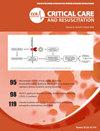体外膜氧合支持下成人重症监护病房患者压伤的流行病学分析。
IF 1.4
4区 医学
Q3 CRITICAL CARE MEDICINE
引用次数: 0
摘要
目的:探讨成人体外膜氧合(ECMO)患者压力性损伤(PI)发生的流行病学及临床特点。设计:回顾性、观察性、队列研究,时间为2018年1月至2023年5月。环境:单中心大容量ECMO专科重症监护病房(ICU)。受试者:所有入住ICU超过24小时的成年人(18岁或以上)。主要结局指标:入住ICU后超过24小时出现PI。结果:500例ICU患者在研究期间接受ECMO支持。不包括n = 25/96个pi(26.0%)和骶骨区(n = 31/96个pi, 32.3%)。只有3例pi与ECMO插管、电路或敷料有关。结论:有相当比例的患者在接受ECMO时发生PIs。需要对医疗器械相关PI的预防保持警惕。性别、肾脏替代治疗、口服饮食和机械通气时间是该人群PI发展的独立预测因素。本文章由计算机程序翻译,如有差异,请以英文原文为准。
The epidemiology of pressure injuries in adult intensive care unit patients supported with extracorporeal membrane oxygenation
Objective
To describe the epidemiology and clinical features of pressure injury (PI) development in adult patients supported with extracorporeal membrane oxygenation (ECMO).
Design
Retrospective, observational, cohort study from January 2018 to May 2023.
Setting
A single-centre high-volume ECMO specialist intensive care unit (ICU).
Participants
All adults (aged 18 y or more) admitted to ICU for more than 24 h.
Main Outcome Measures
Any PI developing more than 24 h after ICU admission.
Results
Five-hundred ICU patients were supported with ECMO during the study period. Excluding those <18 years of age and with an ICU length of stay of <24 h, 466 patients were included in the analysis. One-hundred-thirty-five (29.0%) patients acquired at least one PI during their ICU stay, with PI occurring in 80 patients (17.2%) whilst supported on ECMO. The PI incidence rate was 1.7 per 100 ECMO patient-days (confidence interval: 1.3–2.0). Patients with a PI were mechanically ventilated for longer, received more renal replacement therapy, manifested more delirium, and stayed longer in the ICU and hospital. Conversely, crude ICU and in-hospital mortality was lower in the PI group. A longer ECMO run time and a higher proportion of veno-venous ECMO was also noted in those with a PI. Factors independently associated with the acquisition of a PI were male gender, oral dietary intake, renal replacement therapy, and prolonged mechanical ventilation. The majority of the PIs acquired during ECMO were stage-two and were most commonly located on the neck and head (n = 25/96 PIs, 26.0%) and sacral region (n = 31/96 PIs, 32.3%). Only three PIs were in relation to the ECMO cannula, circuit, or dressing.
Conclusion
A significant proportion of patients develop PIs while receiving ECMO. Vigilance on the prevention of medical device related PI is required. Gender, renal replacement therapy, oral diet, and length of mechanical ventilation were independent predictors for PI development in this population.
求助全文
通过发布文献求助,成功后即可免费获取论文全文。
去求助
来源期刊

Critical Care and Resuscitation
CRITICAL CARE MEDICINE-
CiteScore
7.70
自引率
3.40%
发文量
44
审稿时长
>12 weeks
期刊介绍:
ritical Care and Resuscitation (CC&R) is the official scientific journal of the College of Intensive Care Medicine (CICM). The Journal is a quarterly publication (ISSN 1441-2772) with original articles of scientific and clinical interest in the specialities of Critical Care, Intensive Care, Anaesthesia, Emergency Medicine and related disciplines.
The Journal is received by all Fellows and trainees, along with an increasing number of subscribers from around the world.
The CC&R Journal currently has an impact factor of 3.3, placing it in 8th position in world critical care journals and in first position in the world outside the USA and Europe.
 求助内容:
求助内容: 应助结果提醒方式:
应助结果提醒方式:


